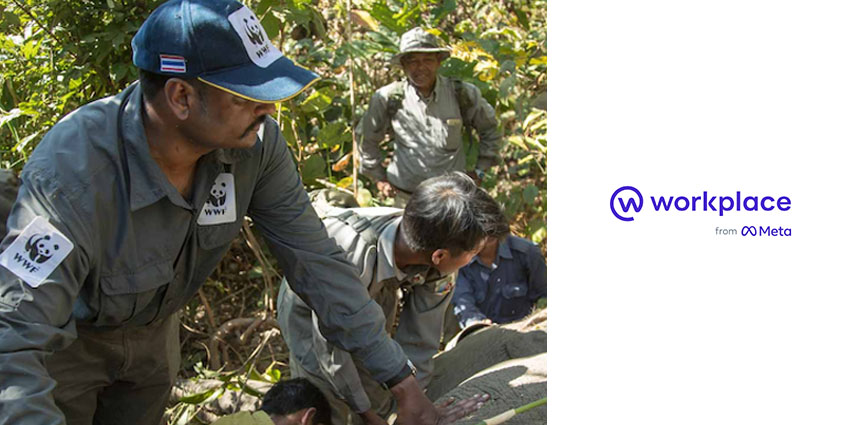Few things are more important in a fast-paced non-profit environment than keeping teams properly connected. The correct flow of knowledge in a non-profit organisation allows for access to more creative fundraising ideas, better productivity, and enhanced outcomes on a low budget.
In recent years, keeping highly distributed teams in the non-profit sector connected has required a greater focus on and investment in cloud-based technologies. This is something the World Wide Fund for Nature (WWF) discovered when looking for new ways to mobilise and enhance its workforce.
With a presence in more than 100 countries and over 6,800 employees, WWF needed access to a flexible and reliable solution for best-in-breed collaboration. Eventually, the company decided to choose Workplace from Meta as its new work hub.
Here’s how Meta and WWF worked together.
Building a New Communication Ecosystem
WWF’s global presence is powered by a host of national offices, each responsible for championing the campaigns relevant to WWF within the region. These national offices are connected to the WWF International ecosystem, offering global coordination and support in areas like wildlife, oceans, forests, energy, climate, freshwater, finance, food, markets, and governance.
Prior to leveraging their new collaboration solution with Workplace from Facebook, the national offices managed by WWF were extremely siloed, with limited visibility into the activities taking place around the globe.
The best-of-breed collaboration tools offered by Workplace have helped to bring various teams and offices together in the same aligned ecosystem, allowing for a better way of working together. According to WWF, Meta’s Workplace technology has helped to build a more unified and powerful global community, equipped to make a larger impact on environmental conservation efforts.
Paolo Mangahas, the Network Communications Officer for WWF says Workplace has assisted in building a more informal culture of information sharing, where everyone can share ideas and updates quickly. The result is an environment where great content can become more “open-sourced” and adaptable. Additionally, there’s even a window where people can connect and build closer personal relationships, so work feels a little more “human”.
Driving Incredible Results with Collaboration
WWF’s communication team reported a 200% increase in engagement within the annual conference for the group in 2018, thanks to the use of Workplace technology. The company has also noted that 100% of its team members can now participate in annual conferences with live video.
The World Wide Fund is made up of a huge selection of environmental specialists and passionate conservationists, all working together to achieve incredible outcomes for the betterment of the planet. Implementing tools like Workforce has allowed the team to identify experts more easily within the internal community, which boosts problem-solving capabilities and collaboration in the teams.
National offices can now share regular updates about what’s going on in their environment, which other offices can learn and take inspiration from. This means WWF is building a more collaborative environment, where information can flow more freely throughout the landscape, without the threat of duplicated work or restricted innovation.
A globally connected economy where work can be shared openly across News feeds and groups have allowed WWF to build a new philosophy known as “#TogetherPossible”, which is all about the power and potential of the collective. A space for open collaboration means teams can listen to each other more effectively and innovate more often.
Boosting Annual Conference Engagement and Partnerships
The Workplace by Meta environment has prompted a huge number of benefits for WWF’s team, including increased engagement at the company’s annual event. In the past, the annual conference was mainly attended by senior stakeholders in WWF and C-level executives. However, with Workplace, the non-profit has been able to get the entire organisation involved.
Live video streaming meant everyone could take part in the conference, leading to significant improvements in engagement for the entire team. The ability to welcome everyone to the conference also helped WWF to gather valuable suggestions from employees who could weigh in with comments during the live sessions.
The Workplace app for mobile also became a critical tool for events within the WWF landscape, with people sharing videos and snaps to keep the wider community informed.
Elsewhere, Workplace’s multi-company groups have also had a direct impact on how WWF works with external stakeholders. The staff members in the team can now share updates and files with stakeholders instantly, turning projects around much faster and answering questions in no time. This is extremely important for a non-profit which relies on being able to act quickly in response to sensitive matters like the illegal wildlife trade.
Building Meaningful Experiences
In the past, WWF’s focus on email for communication simply didn’t deliver the speed the organization needed. Now, Workplace from Meta allows for more immersive and meaningful multi-company group experiences.
For instance, the Earth Hour is one of the biggest and most successful global movements ever created by WWF, helping to raise awareness for climate change and other broader environmental issues.
With 400 non-WWF and WWF partners in this Meta workplace group, the environment has now become the primary internal communication channel for executing and organizing the event. The group has even become a powerful environment for tracking updates, assets, and creative materials related to the event. What’s more, this environment can be used to highlight how over 188 countries and territories celebrate Earth Hour around the world.
With Meta and Workplace, WWF has been able to bring more of its team members together in a shared environment for knowledge, collaboration, and creativity. The Workplace from Meta ecosystem is empowering teams to accomplish more in less time, while simultaneously ensuring employees can build stronger, more meaningful relationships.
WWF has been able to significantly improve productivity and efficiency, without having to deal with complex training procedures to get team members up-to-date on using new technology.







